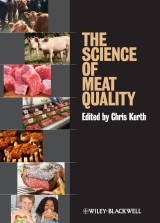Details

The Science of Meat Quality
1. Aufl.
|
187,99 € |
|
| Verlag: | Wiley-Blackwell |
| Format: | |
| Veröffentl.: | 03.04.2013 |
| ISBN/EAN: | 9781118530696 |
| Sprache: | englisch |
| Anzahl Seiten: | 312 |
DRM-geschütztes eBook, Sie benötigen z.B. Adobe Digital Editions und eine Adobe ID zum Lesen.
Beschreibungen
Meat has been a long sought after source of nutrients in human diets. Its nutrient-dense composition of protein, fats, vitamins and minerals makes it an integral part to healthy and balanced diets. As demand for meat continues to increase globally, a better understanding of efficiently producing quality meat products is becoming increasingly important. <i>The Science of Meat Quality</i> provides comprehensive coverage of meat quality from the biological basis of muscle development to end-product-use topics such as preparation and sensory analysis. <p><i>The Science of Meat Quality</i> explores the basis of meat quality long before it hits grocery store shelves. The book opens with a look at cellular muscle tissue development, metabolism and physiology. Subsequent chapters look at topics surrounding the development of tenderness, water-holding capacity, lipid oxidation and color in meat products. The final chapters discuss producing a good-tasting end product from preparing meat to preventing food-borne illness. Each chapter contains not only the theory behind that topic, but also detailed lab methodologies for measuring each meat quality trait.</p> <p><i>The Science of Meat Quality</i> is an essential resource and reference for animal scientists, meat scientists, food scientists, and food industry personnel.</p> <p>Meat has been a long sought after source of nutrients in human diets. Its nutrient-dense composition of protein, fats, vitamins and minerals makes it an integral part to healthy and balanced diets. As demand for meat continues to increase globally, a better understanding of efficiently producing quality meat products is becoming increasingly important. <i>The Science of Meat Quality</i> provides comprehensive coverage of meat quality from the biological basis of muscle development to end-product-use topics such as preparation and sensory analysis.</p> <p><i>The Science of Meat Quality</i> explores the basis of meat quality long before it hits grocery store shelves. The book opens with a look at cellular muscle tissue development, metabolism and physiology. Subsequent chapters look at topics surrounding the development of tenderness, water-holding capacity, lipid oxidation and color in meat products. The final chapters discuss producing a good-tasting end product from preparing meat to preventing food-borne illness. Each chapter contains not only the theory behind that topic, but also detailed lab methodologies for measuring each meat quality trait.</></p> <p><i>The Science of Meat Quality</i> is an essential resource and reference for animal scientists, meat scientists, food scientists, and food industry personnel.</p>
<p>Contributors xv</p> <p>Chapter 1 Growth of Muscle from the Myoblast toWhole Muscle 1<br /><i>Terry Brandebourg</i></p> <p>Chapter 2 Animal Growth and Empty Body Composition 29<br /><i>Michael Dikeman</i></p> <p>Chapter 3 Muscle Structure and Cytoskeletal Proteins 49<br /><i>Chris R. Kerth</i></p> <p>Chapter 4 Muscle Metabolism and Contraction 65<br /><i>Chris R. Kerth</i></p> <p>Chapter 5 Converting Muscle to Meat: The Physiology of Rigor 79<br /><i>Kirk W. Braden</i></p> <p>Chapter 6 Meat Tenderness 99<br /><i>Chris R. Kerth</i></p> <p>Chapter 7 Water-Holding Capacity of Meat 119<br /><i>Jason K. Apple and Janeal W.S. Yancey</i></p> <p>Chapter 8 Lipids and Lipid Oxidation 147<br /><i>Kyle Willian</i></p> <p>Chapter 9 Meat Color 177<br /><i>Richard Mancini</i></p> <p>Chapter 10 Meat Cookery 199<br /><i>Clinton Rowe and Chris R. Kerth</i></p> <p>Chapter 12 Untrained Sensory Panels 215<br /><i>Patricia C. Curtis</i></p> <p>Chapter 13 Consumer Sensory Panels 233<br /><i>Ryan Cox</i></p> <p>Chapter 14 Preventing Foodborne Illness 249<br /><i>Michael A. Davis</i></p> <p>Index 283</p> <p>A color plate section is located between pages 192 and 193.</p>
<p><b>Chris R. Kerth </b>is Associate Professor of Meat Science and Muscle Biology in the Department of Animal Science at Texas A&M University, USA.</p>
<p>Meat has been a long sought-after source of nutrients in human diets. Its nutrient-dense composition of protein, fats, vitamins, and minerals makes it an integral part of healthy and balanced diets. As demand for meat continues to increase globally, a better understanding of efficiently producing quality meat products is becoming increasingly important. The Science of Meat Quality provides comprehensive coverage of meat quality from the biological basis of muscle development to end-product-use topics such as preparation and sensory analysis.</p> <p>The Science of Meat Quality explores the basis of meat quality long before it hits grocery store shelves. The book opens with a look at cellular muscle tissue development, metabolism, and physiology. Subsequent chapters look at topics surrounding the development of tenderness, water-holding capacity, lipid oxidation, and color in meat products. The final chapters discuss producing a good-tasting end product from preparing meat to preventing food-borne illness. Each chapter contains not only the theory behind that topic, but also detailed lab methodologies for measuring each meat quality trait.</p> <p><i>The Science of Meat Quality</i> is an essential resource and reference for animal scientists, meat scientists, food scientists, and food industry personnel.</p>

















